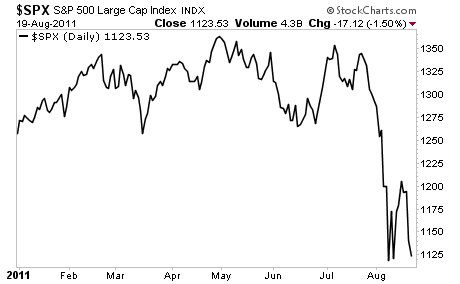It is ironic that stocks are at five years highs going into what is
probably going to be the biggest disappointment of an earning`s season
since the 2008 financial crisis. We got a hint of 4th quarter results
during the disaster which was the 3rd quarter earning`s season where
most companies missed on the revenue side, and those that beat EPS
guidance, did so barely, and most of that was created through stock
buybacks and creative smoothing techniques.
Make no mistake when a public company sets earning`s guidance these
are numbers that are very conservative, and they expect to blow these
numbers away given a healthy business environment. When a company just
barely hits or beats the EPS number, and misses on revenue you know they
were buying back stock, and trying any possible financial trick to
attain the EPS number. One of the oldest tricks on Wall street, besides
giving easy guidance so that when it comes time for earning`s the stock
shoots up because they “beat” expectations.
The fact that companies have to struggle so much just to meet
expectations tells how bad things are from a corporate profit
standpoint. They have cut their operations to the bone for the last
three years, and built earnings up from the bottom, and that strategy
has reached its point of exhaustion. No more to be squeezed out of that
cost cutting strategy.
The Fiscal Cliff
Moreover, with the continual uncertainty coming out of Washington
from a policy perspective, code word the Fiscal Cliff, it`s unlikely
that CEO`s committed much towards year end discretionary CAP EX
purchases which would spur corporate growth during the fourth quarter.
So expect to hear the term Fiscal Cliff during Earning`s season quite a
lot as the primary excuse for business headwinds by the executive teams
during conference calls.
Deja Vu
Last quarter stocks were at these same levels, and companies started
missing and no one wanted to sell hoping that they would get better
earning`s reports, but firms just kept missing, and getting taken down
one by one while the market stayed afloat at elevated levels.
Then more and more firms were missing on the same days, the big boys
started missing, and finally the shorts were going to take multiple
firms stocks down on the same day, and Wall Street pumpers threw in the
proverbial towel on an options expiration Friday of all days, and took
prices down to the next level in most stocks.
In other words, they tried to ignore the bad earnings and keep the
rally alive, but the shorts are going to punish bad earning`s regardless
of bullish sentiment.
Expect the same pattern of behavior as most fund managers are sheep
and too stupid to actually get out before earnings season starts, and
buy after the inevitable selloff. They wait and hope and once one big
player unloads they all run for the exits at the same time leaving quite
a carnage in stocks along the way. One benefit is that short sellers
can get some very cheap puts and establish some very attractive entry
points for the inevitable ride back below 1400 in the S&P 500.
The Debt Fight
Moreover, with the upcoming fight over increasing the debt limit just
around the corner expect quite a sizable selloff in markets which sends
everybody back into the comforts of bonds teasing bond vigilantes once
again, and reminding everyone including the fed that we really are still
in a deflationary, deleveraging cycle that will not turn until true
growth based upon sound financial principles are in place in Washington.
Washington is the biggest reason this economy has taken so long to
recover from the financial crisis in 2008. And their ineptitude has
caused the fed to overcompensate with an unprecedented and borderline
extreme monetary solution which remains to be seen what the eventual
unintended consequences are of said policy.
As this is new territory for the fed, and a grand experiment which
economists will be analyzing for the next 50 years of academic study as
to the ultimate costs & benefits to our society.
Cost cutting versus top-line growth
Corporations have had to watch costs the last three years, work their
employees longer hours, control costs from an operational standpoint,
i.e., operate more efficiency and take advantage of low financing and
borrowing costs to manufacture earnings where they can through stock
buybacks and creative use of capital.
But the one thing that hasn`t been present for corporations is an
environment where the economy is robust and we are adding 500,000 jobs a
month to the economy, and they can afford to hire and grow profits from
the top line through new growth opportunities.
Expect to see the 4th quarter earning`s season reflective of
squeezing all that can be had from the bottom line over the last three
years, and the lack of true growth opportunities, which showed its ugly
head during the 3rd quarter earnings results, make a pronounced
appearance this earning`s season.
Fund Managers are slow learners
Stocks will get hit hard as shorts take down the earning`s misses one
by one, until the fund managers get the hint, and start selling before
the shorts eat into their profits, and start dumping everything mid-way
through this earning`s season.
The excuses will be prevalent, all pointing to a lack of certainty
out of Washington, but the real reason is that you can only cut your way
to profits for so long before you need actual real growth in the
economy, and apart from the slight uptick from the bottom in the housing
market, the rest of the economy is just not robust enough to produce
earning`s growth that is reflective of top line opportunities.
By EconMatters
source
here


![[Most Recent USD from www.kitco.com]](http://www.weblinks247.com/indexes/idx24_usd_en_2.gif)




